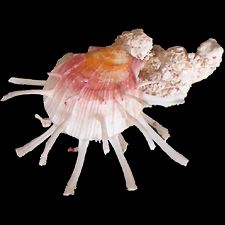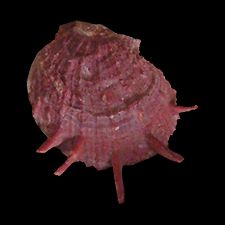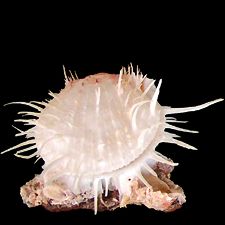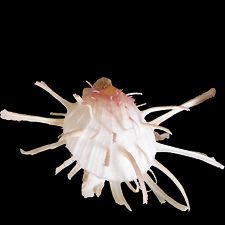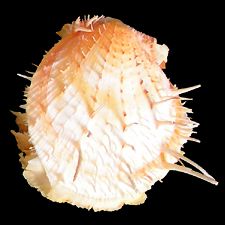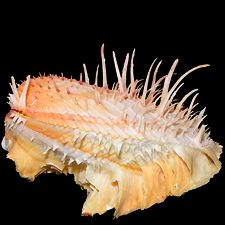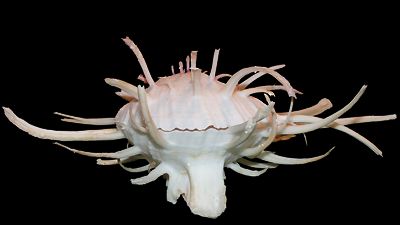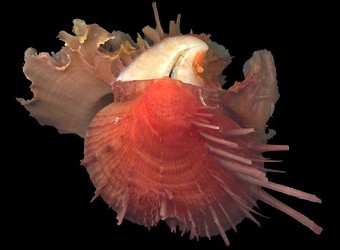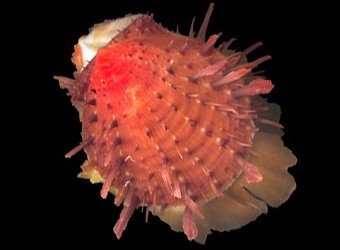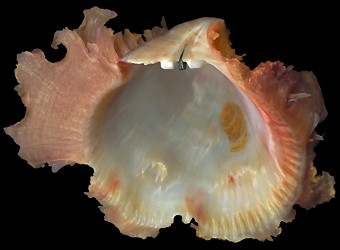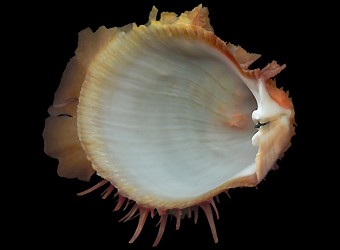Spondylus americanus, Spondylus ictericus.

Background:
- MIKE: Here in SoFla we call them "thorny oysters" and they are abundant, especially on wrecks. I'm told they are all the same species (S. americanus) but the variations between specimens is huge, mostly depending on substrate and exposure to current. Deep inside the wrecks, the spines are widely separated, long, and flat. The shell has pronounced curvature and is generally white. On exposed areas of the reef, the spines are close together, short, and rounded. The shell is flatter and dark red to light orange.
- PEGGY: Correction, Mike: the deeper water shells are Spondylus americanus. They can be white, pink, orange, red or yellow. The ones from about 50 feet that are brick red with white speckles on the umbo are Spondylus ictericus. They have fewer spines, are smaller, and the spines may be spatulate or "fingered".
- MIKE: I suspected the brick red ones were a different species. They are common on the reef but not on the wrecks. But I have what I am sure are S. americanus, some with short spikes, some with long spatulate spikes. The difference seems to be exposure to current.
- DAVID: I'm just wondering how frequently Spondylus americanus has been identified when S. ictericus is actually present. Judging by my attempts to ID Spondylus from Thailand, distinguishing variability from species-differences in this genus has got to be among the most difficult in conchology. Even after I got some assistance, I still couldn't be confident in diagnosing them. Who are the Spondylus experts and what do they rely on?
- PEGGY: Spondylus americanus is common in Florida on both coasts, mostly at about 100 feet. Farther south in the Caribbean it is shallower, and I've found it intertidally even in the Abacos (Bahamas) and in Honduras. S. ictericus in Florida is usually at about 50 feet or a little less or more. I've found it intertidally in Bermuda. It is ALWAYS at least partly brick red and usually has those white spots on the umbones. I do have one with yellow spines but the shell itself is brick red. Any other color combination is probably S. americanus. S. americanus can be very spiny (inside wrecks) with a huge "skirt" along the base of the lower valve or have fewer, longer spines (outside wrecks and on reefs). The best ones are covered with sponge when found - the spines don't break and grow long. The intertidal ones are ugly, with very short and sometimes no spines.
- DAVE: I'm not sure how variable or consistent the muscle scar patterns within Spondylus shells are, but such patterns might aid in distinguishing individual species.
- PEGGY: Correction, Mike: the deeper water shells are Spondylus americanus. They can be white, pink, orange, red or yellow. The ones from about 50 feet that are brick red with white speckles on the umbo are Spondylus ictericus. They have fewer spines, are smaller, and the spines may be spatulate or "fingered".
- MIKE: I suspected the brick red ones were a different species. They are common on the reef but not on the wrecks. But I have what I am sure are S. americanus, some with short spikes, some with long spatulate spikes. The difference seems to be exposure to current.
- DAVID: I'm just wondering how frequently Spondylus americanus has been identified when S. ictericus is actually present. Judging by my attempts to ID Spondylus from Thailand, distinguishing variability from species-differences in this genus has got to be among the most difficult in conchology. Even after I got some assistance, I still couldn't be confident in diagnosing them. Who are the Spondylus experts and what do they rely on?
- PEGGY: Spondylus americanus is common in Florida on both coasts, mostly at about 100 feet. Farther south in the Caribbean it is shallower, and I've found it intertidally even in the Abacos (Bahamas) and in Honduras. S. ictericus in Florida is usually at about 50 feet or a little less or more. I've found it intertidally in Bermuda. It is ALWAYS at least partly brick red and usually has those white spots on the umbones. I do have one with yellow spines but the shell itself is brick red. Any other color combination is probably S. americanus. S. americanus can be very spiny (inside wrecks) with a huge "skirt" along the base of the lower valve or have fewer, longer spines (outside wrecks and on reefs). The best ones are covered with sponge when found - the spines don't break and grow long. The intertidal ones are ugly, with very short and sometimes no spines.
- DAVE: I'm not sure how variable or consistent the muscle scar patterns within Spondylus shells are, but such patterns might aid in distinguishing individual species.
